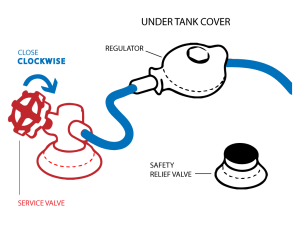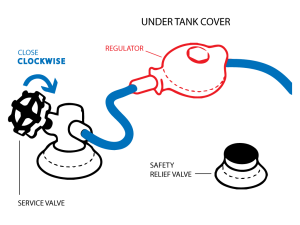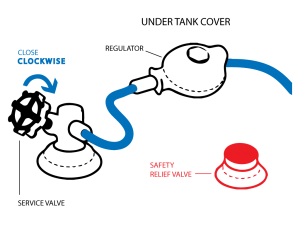When you own a home or business powered by propane, knowing about propane tank safety is essential. There are certain safety features under your tank’s cover every propane user should be aware of. A propane tank has three safety valves, or components: a service valve, a regulator, and a safety relief valve. These key components are discussed below. Your knowledge of proper propane tank safety can protect you and your family in the case of an unexpected natural disaster or potential leak. Also, learning how to detect a potential leak in your propane system is another added layer of protection.
Armed with the information below, you can feel confident should you ever need to shut off your own propane supply temporarily. It is important to note, consumers should never turn their propane supply back on, on their own. Always contact Delta Liquid Energy and schedule one of our certified technicians to come to your home or business and do this for you.
Whether you are using propane for rural living or on your farm to grow and harvest crops, these propane tank safety tips will help you maintain a level of comfort.
The Service Valve
A propane tank service valve is your “shut-off” valve. It looks like a metal spigot or dial and is plumbed to the top of the tank. You should use this valve to turn the gas off at the tank during an emergency or leak. This is the only safety feature that a consumer should handle. Rely on a professional service technician to handle the other two safety features discussed here. Always turn this valve all the way to the right (clockwise), to fully shut off your propane supply.

The Regulator
The regulator is a flat, circular piece connected by a tube to the shut-off valve. This piece of equipment controls the flow and pressure of propane being delivered from the tank to your home’s appliances. Typically, you will have a first-stage regulator on your tank and a second-stage regulator at the propane line connection to your house.

The Safety Relief Valve
The round, capped safety relief valve is located near the shut-off valve on the base of the tank. This protects the tank in the case of high-pressure situations caused by emergency events such as a fire. The valve may open on its own if the pressure inside the tank gets too high and will close again when the pressure returns to normal. Inside the safety relief valve is a spring and diaphragm mechanism. If too much pressure builds in the diaphragm, the spring will release and open the safety relief valve. Be sure to always keep your face and hands clear of this valve.

It is important to always keep your eyes, ears and nose out for warning signs of any problems with your propane tank. “Rotten-egg” odors and whistling sounds that signify a leak are such signs. Be sure to take immediate action and call 911 then Delta Liquid Energy if there are signs of danger.
What to Do in Bad Weather:
Flood: Turn off the propane tank service valve at the cylinder or tank before water rises.
Snow: Clear heavy snow and ice from regulators, regulator vents, piping, tubing, and valves. Also, keep clear your appliance vents, chimneys, and flues. This will be an ongoing task as you do not want snow built up on any of your propane tank safety features.
Storm: Turn off the main propane service valve if tank shifts position or if propane lines are bent, broken or damaged. Only do this if it is safe to do so.
Extreme weather can come in other forms too, check out our other blog posts about propane safety in extreme weather:
